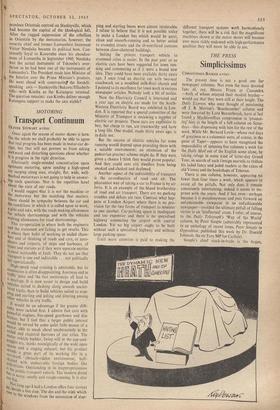MOTORING
Transport Continuum
OLIVER STEWART writes:
Once again the season of motor shows is here. On the whole we shall probably be able to agree that real progress has been made in motor-car de- sign; but that will not prevent us from asking awkward and disturbing questions about whether It is progress in the right direction.
Gloriously single-minded concentration upon optimum motoring, upon sending a high-speed Car surging along nice, straight, flat, wide, well- Marked motorways is not going to help in answer- ing such questions. Nor is the repetitive howl about the state of our roads.
I would suggest that it is not the machine or the motorway but the matching that matters. There should be sympathy between the car and the conditions in which it is called upon to work, a give and take, with the roads making allowances for vehicle shortcomings and with the vehicles making allowances for road shortcomings.
This co-operation is where both the engineers and the statesmen are failing to get results. This is where their habit of working in sealed cham- bers and of thinking of roads and cars, or aero- planes and airports, of ships and harbours, of trains and stations as if they were separate entities most noticeably at fault. They do not see that transport is one and indivisible ... not politically but operationally.
High-speed road cruising is admirable, but its
trade is often disappointing. Journeys end in 'affle jams and the fast motorways all lead to a snarl-up. It is now easier to design and build vehicles suited to dashing along smooth unclut- tered tracks than to build vehicles suited to stop- Ping and starting and jolting and jittering among other vehicles in city traffic.
would be an advantage if the greater diffi- cilitY were tackled first. I admire fast cars with powerful engines, five-speed gearboxes and disc brakes; but I feel that a larger public interest w ,211Id be served by some quiet little mouse of a o"c"°tor, able to sneak about unobtrusively in the motor and claustral burrows of our cities. The vehicle builder, living still in the cap-and- boggles era, thinks nostalgically of the wide open spaces and a singing exhaust; but his product ree,rld. s a great part of its working life in a obstacle-ridden environment, half- pe,°ked with undesirable foreign bodies like is u_estrians. Outstanding in its inappropriateness the Public transport vehicle. The modern diesel u is . top noisy, smelly and rough-running. It is also ig.
up beg long ago I had a London office four storeys 4e ro,_Kie a bus stop. The din and the stink which to the windows from the succession of stop-
ping and starting buses were almost intolerable, I refuse to believe that it is not possible today to make a London bus which would be quiet, clean and smooth-running and so better suited to crowded streets and the ill-ventilated canyons between close-clustered buildings.
Suiting the private transport vehicle to crammed cities is easier. In the past year or so electric cars have been suggested for town run- ning and commuting as if it were a brand new idea. They could have been available thirty years ago. I once tried an electric car with two-seat coachwork on a modified milk-float chassis and I pointed to its excellence for town work in various newspaper articles. Nobody took a bit of notice.
Now the Electricity Council is interested and a year ago an electric car made for the South- Western ElectricityBoard was exhibited in Lon- don. It is reported that a special committee of the Ministry of Transport is reviewing a number of electric car projects. These cars are expensive to buy, but cheap to run, are trustworthy and have a long life. One model, made thirty years ago, is in daily use.
But the success of electric vehicles for town running would depend upon providing them with a suitable environment; an extension of the pedestrian precinct scheme might do. If they were given a chance I think they would prove popular. And they could save city dwellers from being smoked and choked and deafened.
Another aspect of the indiVisibility of transport .is the co-ordination of road and air. The pleasantest way of taking a car to France is by air ferry. It is an example of the blood brothership of road and air transport. There are no parking troubles and delays are rare. Contrast what hap- pens at London Airport where there is no pro- vision for the two forms of transport to minister to one another. Car-parking space is inadequate and too expensive and there is no specialised highway connecting the airport with central London. Yet no big airport ought to be built without such a specialised highway and without large parking space.
Until more attention is paid to making the _different transport systems work harmoniously together, there will be a risk that the magnificent machines shown at the motor shows will become ever more richly endowed with high-performance qualities they will never be able to use.






























 Previous page
Previous page